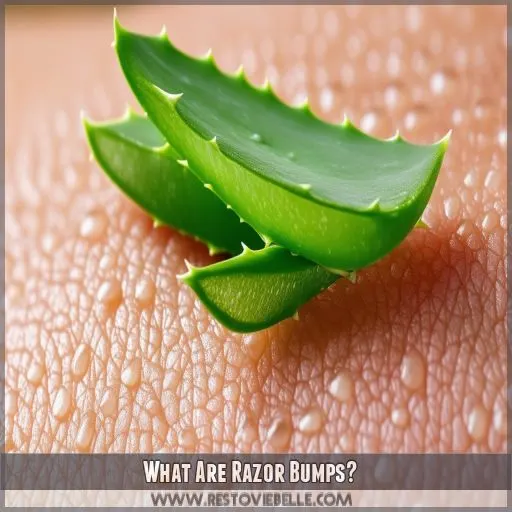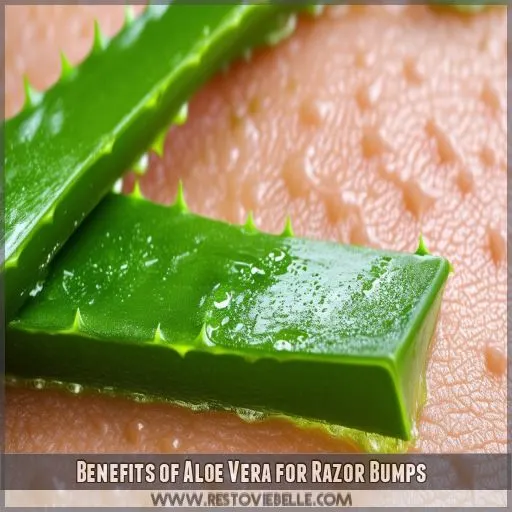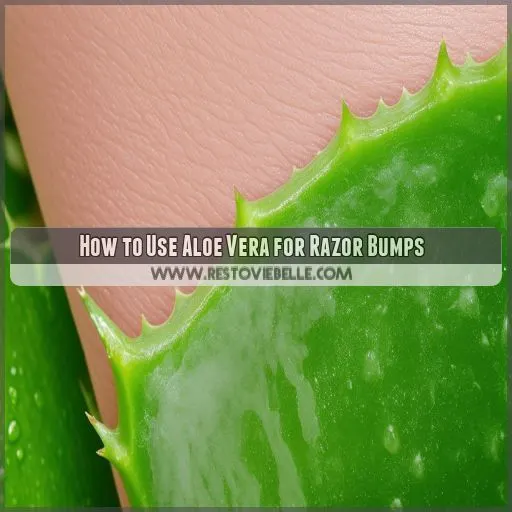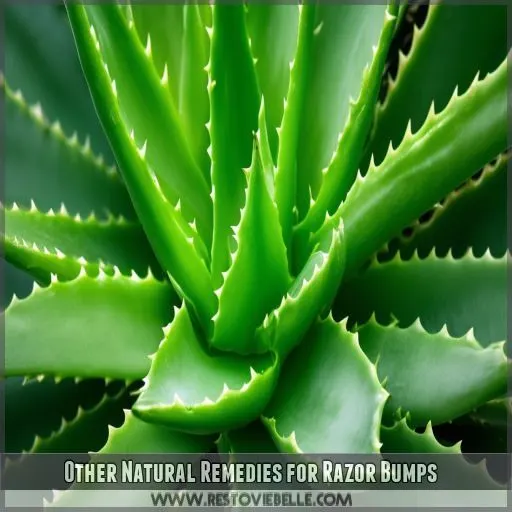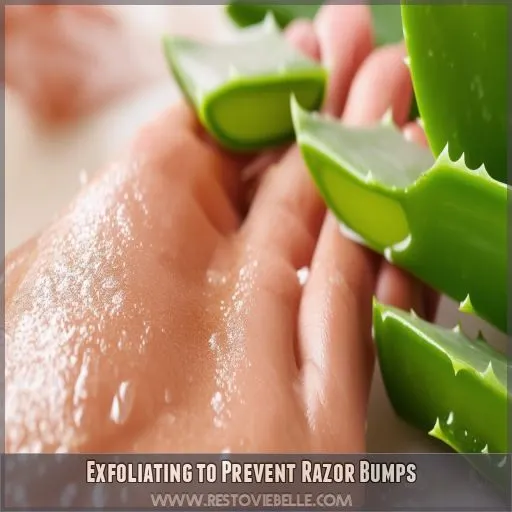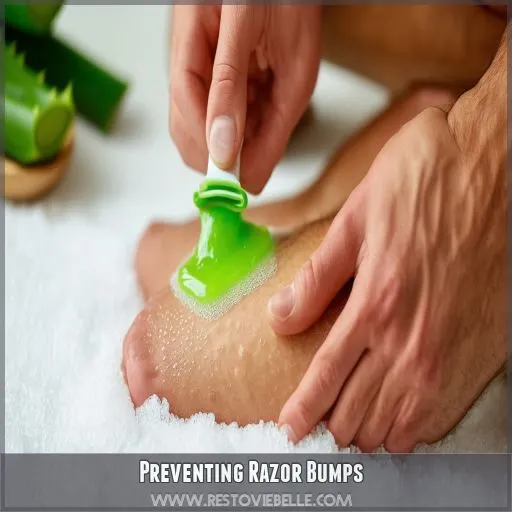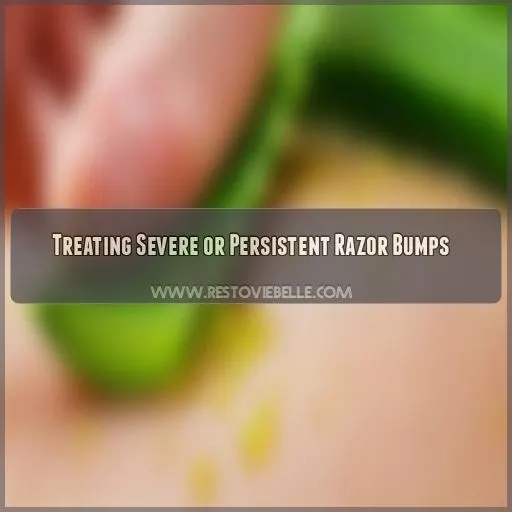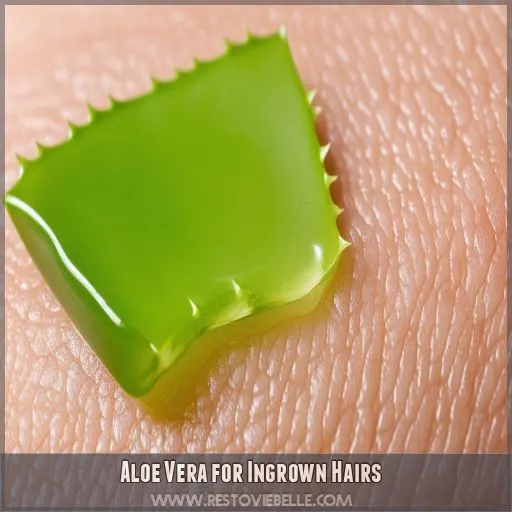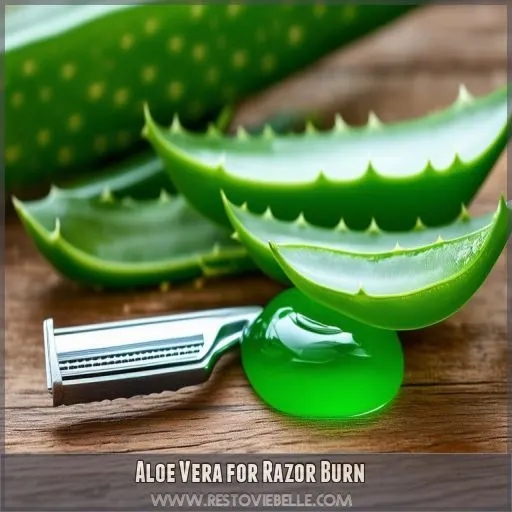This site is supported by our readers. We may earn a commission, at no cost to you, if you purchase through links.
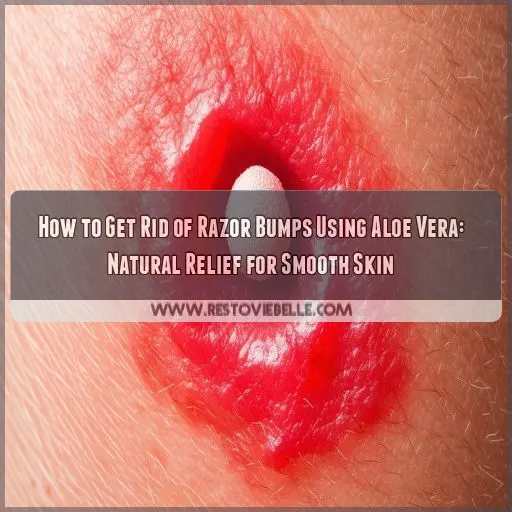 To get rid of razor bumps using aloe vera, start by cleansing the affected area. Extract fresh gel from an aloe leaf or use a store-bought aloe vera product. Apply the gel directly to your razor bumps, gently massaging it in. Let it absorb for 15-20 minutes before rinsing with cool water. Repeat this process 2-3 times daily for best results.
To get rid of razor bumps using aloe vera, start by cleansing the affected area. Extract fresh gel from an aloe leaf or use a store-bought aloe vera product. Apply the gel directly to your razor bumps, gently massaging it in. Let it absorb for 15-20 minutes before rinsing with cool water. Repeat this process 2-3 times daily for best results.
Aloe vera’s anti-inflammatory properties help reduce redness and swelling, while its soothing effects calm irritated skin. It also moisturizes and promotes healing.
For prevention, exfoliate regularly and use proper shaving techniques.
If you’re intrigued by aloe’s benefits, there’s more to discover about this natural remedy.
Table Of Contents
- Key Takeaways
- How to Get Rid of razor bumps Using Aloe Vera?
- What Are Razor Bumps?
- Benefits of Aloe Vera for Razor Bumps
- How to Use Aloe Vera for Razor Bumps
- Other Natural Remedies for Razor Bumps
- Exfoliating to Prevent Razor Bumps
- Preventing Razor Bumps
- Treating Severe or Persistent Razor Bumps
- Aloe Vera for Ingrown Hairs
- Aloe Vera for Razor Burn
- Frequently Asked Questions (FAQs)
- Does aloe vera cure razor bumps?
- What gets rid of razor bumps fast?
- Should I put aloe vera after shaving down there?
- Can aloe vera help with ingrown hairs?
- Can aloe vera prevent razor bumps before shaving?
- How long does aloe vera take to work?
- Is store-bought aloe vera gel as effective?
- Can aloe vera reduce scarring from razor bumps?
- Are there any side effects of using aloe vera?
- Conclusion
Key Takeaways
- Aloe vera is your skin’s new BFF! Its anti-inflammatory and soothing properties are like a cool drink for your irritated razor bumps, helping to calm redness and swelling faster than you can say "smooth operator."
- Don’t just slap on the aloe and call it a day. For best results, cleanse the affected area first, then gently massage in fresh aloe gel or a high-quality store-bought product. Let it soak in for 15-20 minutes before rinsing – it’s like a mini spa treatment for your razor bumps!
- Prevention is worth a pound of cure, as they say. Exfoliate regularly, use a sharp razor, and always shave with the grain. It’s like giving your skin a fighting chance against those pesky bumps before they even start.
- If aloe vera isn’t cutting it (pun intended), don’t throw in the towel just yet. There’s a whole arsenal of natural remedies like tea tree oil and witch hazel waiting in the wings. And if all else fails, it might be time to wave the white flag and consult a dermatologist – no shame in calling in the big guns!
How to Get Rid of razor bumps Using Aloe Vera?
To get rid of razor bumps using aloe vera, apply fresh aloe vera gel or an aloe-based cream directly to the affected area twice daily. The anti-inflammatory and soothing properties of aloe vera can help reduce redness, swelling, and irritation associated with razor bumps, promoting faster healing and smoother skin.
What Are Razor Bumps?
Razor bumps occur when hair curls back into the skin after shaving, causing inflammation and irritation. You may experience raised, red bumps, itching, and pain in affected areas, particularly if you have curly hair or are prone to ingrown hairs.
Causes of Razor Bumps
Razor bumps, also known as pseudofolliculitis barbae (PFB), occur when hair curls back into the skin, causing irritation. You’re more likely to experience this if you have curly or coarse hair. The main culprits behind these pesky bumps are:
- Shaving too close to the skin
- Using dull razors
- Shaving against the grain
- Dry shaving without lubrication
Risk factors include being African-American or Hispanic, and having naturally curly hair. Affected areas typically include the face, neck, underarms, and groin. Don’t confuse PFB with conditions like tinea barbae or sycosis barbae.
Symptoms of Razor Bumps
After shaving, you might notice some uncomfortable symptoms of razor bumps. These pesky irritations can manifest in various ways:
| Symptom | Description |
|---|---|
| Appearance | Raised, red bumps |
| Sensation | Itching and pain |
| Skin Changes | Darkening of affected areas |
| Texture | Small papules or pustules |
These symptoms can be frustrating, but don’t worry! Understanding them is the first step towards effective treatment. Whether you’re dealing with skin inflammation, redness, or those annoying bumps, there are solutions. From aloe vera to laser hair removal, you’ve got options to soothe your skin and banish those razor burns.
Benefits of Aloe Vera for Razor Bumps
Aloe vera offers multiple benefits for treating razor bumps, including its anti-inflammatory properties, soothing and cooling effects, and moisturizing benefits. These properties work together to reduce irritation, calm inflamed skin, and promote healing of razor bumps, making aloe vera an effective natural remedy.
Anti-inflammatory Properties
Aloe vera’s role in combating razor bumps goes beyond soothing. Its anti-inflammatory properties target the root cause of irritation. By reducing inflammation, aloe vera helps calm angry skin and promotes healing. This natural remedy works wonders for post-shave care, addressing skin rashes and dryness while providing much-needed relief.
Soothing and Cooling Effects
Aloe vera’s soothing and cooling effects complement its anti-inflammatory properties. When applied to razor bumps, it provides instant relief. Here’s how it works:
- Reduces skin temperature
- Calms irritated nerve endings
- Promotes blood circulation
- Accelerates healing process
Use a cool aloe vera compress for maximum benefit.
Moisturizing Benefits
Aloe vera’s moisturizing benefits can help soothe and heal razor bumps. It’s packed with hydrating properties that nourish your skin. Here’s a breakdown of how aloe vera moisturizes:
| Property | Benefit | Effect on Razor Bumps |
|---|---|---|
| Humectant | Attracts moisture | Reduces inflammation |
| Emollient | Softens skin | Eases discomfort |
| Occlusive | Locks in moisture | Promotes healing |
| Polysaccharides | Hydrate deeply | Prevents scarring |
| Vitamins | Nourishes skin | Speeds recovery |
How to Use Aloe Vera for Razor Bumps
You can effectively use aloe vera for razor bumps in three main forms: fresh aloe vera gel, aloe vera cream or lotion, and aloe vera supplements. Each method offers unique benefits, with fresh gel providing direct application, creams offering convenience, and supplements supporting skin health from within.
Fresh Aloe Vera Gel
Fresh aloe vera gel is a potent natural remedy for razor bumps. Here’s how to harness its benefits:
- Cut an aloe leaf and extract the gel
- Apply directly to affected areas
- Let it absorb for 15-20 minutes
- Rinse with cool water
- Repeat 2-3 times daily for best results
This method maximizes aloe’s anti-inflammatory and moisturizing effects.
Aloe Vera Cream or Lotion
If you prefer a more convenient option, aloe vera creams or lotions can be effective. Here’s a comparison of popular choices:
| Brand | Key Ingredients | Skin Type |
|---|---|---|
| CeraVe | Aloe, Ceramides | All types |
| Burt’s Bees | Aloe, Coconut Oil | Dry |
| Vaseline | Aloe, Petrolatum | Sensitive |
| Neutrogena | Aloe, Glycerin | Oily |
| DIY | Fresh Aloe, Essential Oils | Custom |
Choose based on your skin’s needs for effective razor bump relief.
Aloe Vera Supplements
While topical treatments are popular, oral aloe vera supplements can also help combat razor bumps from within. They’re available in capsules or liquid form. However, be cautious with dosage and potential side effects. Always consult your doctor before starting, especially if you’re on medications or have underlying health conditions.
Other Natural Remedies for Razor Bumps
While aloe vera is effective, you can also try other natural remedies for razor bumps. Tea tree oil, witch hazel, and coconut oil each offer unique benefits for soothing irritated skin and reducing inflammation caused by shaving.
Tea Tree Oil
Tea tree oil‘s powerful antibacterial and anti-inflammatory properties make it an excellent natural remedy for razor bumps. Apply a diluted solution to affected areas to combat folliculitis and inhibit hair growth. Combined with aloe vera, it forms a potent duo for soothing irritated skin and promoting healing.
Witch Hazel
Witch hazel’s astringent and antiseptic properties make it an effective remedy for razor bumps. It can help:
- Reduce skin irritation
- Soothe inflamed follicles
- Prevent infection
Apply witch hazel to affected areas after shaving. Combine it with aloe vera for enhanced benefits in treating folliculitis barbae and ingrown hairs.
Coconut Oil
Coconut oil is another natural remedy for razor bumps. Its antimicrobial and moisturizing properties make it an excellent treatment option. Here’s a comparison of coconut oil with other natural remedies:
| Remedy | Antimicrobial | Moisturizing | Anti-inflammatory | Easy to Apply |
|---|---|---|---|---|
| Coconut Oil | Yes | High | Moderate | Yes |
| Aloe Vera | Yes | Moderate | High | Yes |
| Tea Tree Oil | High | Low | Moderate | No |
| Witch Hazel | Moderate | Low | High | Yes |
Exfoliating to Prevent Razor Bumps
Exfoliating plays a vital role in preventing razor bumps by removing dead skin cells and unclogging pores. You can choose from physical exfoliants like scrubs or chemical exfoliants such as alpha-hydroxy acids, and gently apply them using circular motions before shaving to prepare your skin.
Importance of Exfoliation
While aloe vera soothes razor bumps, don’t forget exfoliation‘s essential role. It removes dead skin cells that clog pores and trap hair follicles, preventing those pesky bumps. Regular exfoliation is key to your skin care routine, preparing your skin for a smoother shave. Remember, a well-exfoliated face is a happy face!
Types of Exfoliants
When battling razor bumps, you’ve got three exfoliant types in your arsenal: physical, chemical, and enzymatic. Physical scrubs use particles, while chemical exfoliants dissolve dead skin cells. Enzymatic options, often fruit-based, gently break down skin proteins. For sensitive skin prone to pseudofolliculitis barbae, opt for gentle exfoliation methods.
Exfoliating Techniques
To exfoliate effectively, use gentle circular motions with a soft scrub or washcloth. Focus on areas prone to razor bumps, like your neck and jawline. Don’t overdo it; 2-3 times a week is enough. This removes dead skin, unclogs pores, and preps your skin for a smoother shave.
Preventing Razor Bumps
To prevent razor bumps, focus on proper shaving techniques using a sharp razor and shaving with the grain of your hair growth. You’ll minimize irritation and reduce the likelihood of ingrown hairs by using gentle strokes and replacing your razor regularly.
Proper Shaving Techniques
To prevent razor bumps and ingrown hairs, follow these proper shaving techniques:
- Apply warm water to soften hair follicles
- Use shaving gels for lubrication
- Shave in the direction of hair growth
These steps, combined with aloe vera’s soothing properties, can help you achieve smoother skin and reduce irritation.
Using a Sharp Razor
Using a sharp razor is essential for preventing razor bumps. Dull blades tug at hair, causing irritation. Invest in quality razors and replace them regularly. Maintain blade sharpness by cleaning after each use and storing in a dry place. Proper blade angle during shaving also reduces the risk of bumps.
Shaving With the Grain
After ensuring your razor’s sharp, focus on your shaving technique. Shave with the grain, following your hair growth direction. Adjust your razor angle to minimize skin irritation. If you’re sensitive, reduce shaving frequency. This method helps prevent razor bumps by working with your skin’s natural patterns.
Treating Severe or Persistent Razor Bumps
If aloe vera and other natural remedies don’t provide sufficient relief for severe or persistent razor bumps, it’s time to consult a doctor. They may prescribe topical antibiotics or recommend laser hair removal to address the underlying causes of recurring razor bumps.
When to See a Doctor
While aloe vera can work wonders, there’s a time to seek professional help. If you notice signs of infection, worsening razor burn, or painful, fluid-filled lesions, it’s time to call the doctor. Don’t ignore persistent issues – medical intervention might be necessary to prevent complications and restore your skin’s health.
Prescription Treatments
If natural remedies don’t work, your doctor might prescribe antibacterial lotions to combat infection. They may recommend warm compresses to soothe the skin or spot treatment with steroid creams for inflammation. In severe cases, a sterile incision might be necessary to extract the ingrown hair, providing relief from persistent razor bumps.
Laser Hair Removal
If prescription treatments aren’t effective, laser hair removal or electrolysis might be your next step. These methods offer permanent results, targeting hair follicles to prevent regrowth. While costlier upfront, they can save money long-term. Your skin type and hair color will determine which option’s best for you.
Aloe Vera for Ingrown Hairs
Ingrown hairs share many similarities with razor bumps, often causing discomfort and inflammation. Aloe vera’s anti-inflammatory and soothing properties make it an effective natural remedy for treating both conditions, helping to reduce irritation and promote healing.
Similarities to Razor Bumps
While treating severe razor bumps, you might notice similarities to ingrown hairs. Both conditions can cause:
- Redness and inflammation
- Painful, raised bumps
- Itching and irritation
- Risk of infection
Prevention tips and treatment options for razor burn and ingrown hairs often overlap, making aloe vera a versatile natural ingredient for multiple shaving-related issues.
Benefits of Aloe Vera
Aloe vera’s benefits for ingrown hairs mirror its effects on razor bumps. Its antibacterial and anti-inflammatory properties help combat infection and reduce swelling. You’ll appreciate its soothing and cooling effects on irritated skin. Plus, aloe’s moisturizing effects keep your skin hydrated, promoting faster healing and smoother skin.
Treating Ingrown Hairs
Aloe vera’s benefits extend to treating ingrown hairs, too. Its anti-inflammatory properties can soothe irritated skin and reduce redness. To prevent ingrown hairs, combine aloe with gentle exfoliation techniques. For severe cases, natural remedies like aloe mightn’t be enough, so consult a doctor if symptoms persist.
Aloe Vera for Razor Burn
Aloe vera offers natural relief for razor burn by soothing irritated skin and providing cooling, calming effects. Its anti-inflammatory properties help reduce redness and swelling, while its antibacterial qualities can prevent infection in small nicks or cuts from shaving.
Soothing Irritated Skin
Aloe vera’s soothing properties can provide immediate relief for razor burn. Its antibacterial and anti-inflammatory actions help calm irritated skin, while promoting hydration and healing. Apply the gel topically after shaving to experience its benefits. Here’s how aloe vera soothes your skin:
- Calms angry, red patches like a gentle hug for your skin
- Fights off pesky bacteria that could worsen irritation
- Quenches your skin’s thirst, leaving it supple and happy
- Speeds up healing, turning frowns into smooth smiles
- Acts as a natural shield against further irritation
Cooling and Calming Effects
Beyond soothing, aloe vera’s cooling effect provides instant relief for razor burn. Its anti-inflammatory properties reduce redness and swelling, while moisturizing your skin. Here’s a breakdown of aloe vera’s benefits:
| Property | Effect | Duration |
|---|---|---|
| Cooling | Immediate comfort | Instant |
| Anti-inflammatory | Reduces redness | Hours |
| Moisturizing | Hydrates skin | Long-lasting |
| Antibacterial | Prevents irritation | Ongoing |
| Soothing | Calms razor burn | Prolonged |
Preventing Infection
Beyond its cooling effects, aloe vera’s antimicrobial properties help prevent infection in razor burn areas. Its natural anti-inflammatory effects provide soothing relief for irritated skin. Apply a thin layer of pure aloe gel after shaving to create a protective barrier, reducing the risk of bacterial invasion and promoting faster healing.
Frequently Asked Questions (FAQs)
Does aloe vera cure razor bumps?
Aloe vera doesn’t cure razor bumps, but it can help. Its anti-inflammatory properties soothe irritation and reduce redness. Apply pure aloe gel to affected areas after shaving. It’ll moisturize your skin and may speed up healing.
What gets rid of razor bumps fast?
For quick relief from razor bumps, apply a cold compress, use over-the-counter hydrocortisone cream, and avoid shaving for a few days. Exfoliate gently, moisturize regularly, and consider using an electric razor to prevent future irritation.
Should I put aloe vera after shaving down there?
Yes, you can apply aloe vera after shaving your intimate area. It’s soothing, reduces inflammation, and helps prevent razor bumps. Just make certain you’re using pure aloe gel without additives. Always do a patch test first.
Can aloe vera help with ingrown hairs?
Like a soothing balm for your skin’s woes, aloe vera can indeed help with ingrown hairs. Its anti-inflammatory properties reduce redness and swelling, while its moisturizing effects soften skin, potentially helping trapped hairs break free more easily.
Can aloe vera prevent razor bumps before shaving?
You can use aloe vera before shaving to prevent razor bumps. Apply a thin layer to soften hair and moisturize skin. It’ll create a protective barrier, reducing friction and irritation. Don’t forget to rinse thoroughly before shaving.
How long does aloe vera take to work?
You’ll experience a "smooth awakening" within 24-48 hours. Aloe vera’s soothing properties work quickly, reducing inflammation and redness. Apply twice daily for best results. Consistent use over a week guarantees effective healing and prevention of future irritation.
Is store-bought aloe vera gel as effective?
Store-bought aloe vera gel can be effective, but it’s often less potent than fresh aloe. Look for pure, high-quality products with minimal additives. You’ll likely see results, but they may not be as dramatic as using fresh aloe vera.
Can aloe vera reduce scarring from razor bumps?
Yes, aloe vera can help reduce scarring from razor bumps. Its natural healing properties promote skin regeneration and collagen production. Apply pure aloe gel directly to affected areas twice daily for best results. You’ll likely see improvement over time.
Are there any side effects of using aloe vera?
While aloe vera’s generally safe, you might experience mild irritation or allergic reactions. It can also interact with certain medications. If you’re pregnant, diabetic, or have skin conditions, consult your doctor before using it regularly.
Conclusion
With the power of aloe vera in your arsenal, razor bumps don’t stand a chance. You’ve learned how to get rid of razor bumps using aloe vera, along with other natural remedies and prevention techniques.
Remember to cleanse, exfoliate, and shave properly to minimize irritation. If your razor bumps persist or worsen, consult a dermatologist.
